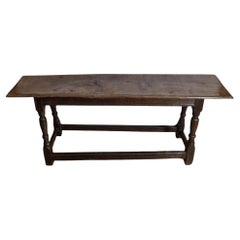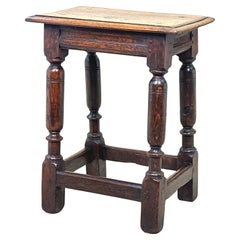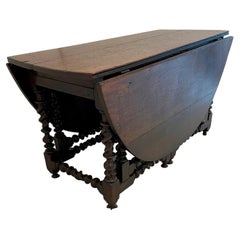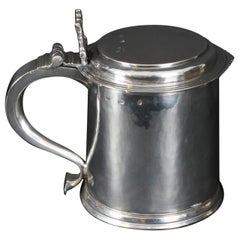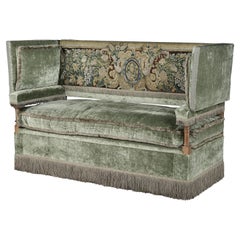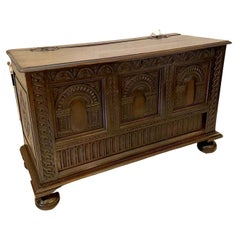Charles II Furniture
to
11
95
52
93
2
103,282
47,716
22,264
21,109
8,903
6,335
4,673
4,401
3,612
3,318
3,216
3,054
3,001
2,425
2,299
2,044
2,001
1,554
76
6
11
2
7
1
2
1
2
1
2
51
36
34
21
17
85
74
45
3
2
95
94
95
1
1
1
1
1
Item Ships From: Europe
Style: Charles II
Early 17th Century Oak Bench 1630 - 1640
Located in Hoddesdon, GB
An early 17th-century oak joined bench, dating from the circa 1630-1640 features a beautiful colour and patination. It has a single thick oak plank top, turned baluster legs, and mou...
Category
17th Century British Antique Charles II Furniture
Materials
Oak
17th Century Rectangular Oak Joint Stool
Located in Bedfordshire, GB
A Very Charming Mid 17th Century, Charles II Period, Oak Joint Stool Of Pegged Construction, Plus Untouched Colour & Patina Throughout, Having Rectangular Moulded Top Over Turned Upright Supports With Original Straight Stretchers.
Sometimes referred to as coffin stools (although this was much more of a 19th century trend for their usage as opposed to their original purpose in earlier times) the humble antique joint stool was by far the most common form of seating in 16th and 17th century England. Indeed they were made in relatively vast quantities and almost every house would have a selection of them on hand in a variety of difference sizes and heights so that they could be used as required.
This antique oak joint stool...
Category
17th Century English Antique Charles II Furniture
Materials
Oak
$3,810 Sale Price
30% Off
Large Antique 17th Century Quality Oak Double Gate Leg Table
Located in Suffolk, GB
Large antique 17th century quality oak double gate leg table having a large quality oak top with two drop leaves supported by bobbin turned and b...
Category
17th Century English Antique Charles II Furniture
Materials
Oak
Antique Charles II English Sterling Silver Tankard 1680 17th Century
Located in London, GB
This is a wonderful antique silver Charles II lidded tankard with hall marks for London 1680, bearing the makers mark T.S whichn is attributed to Thomas Smith by David Mitchell in hi...
Category
1680s Antique Charles II Furniture
Materials
Silver
Knole Settee, Cowdray Park, English, Lengyon & Co, olive velvet, tapestry
Located in BUNGAY, SUFFOLK
- EXCEPTIONALLY, RARE, MUSEUM QUALITY PIECE, THE COWDRAY PARK KNOLE SETTEE, INVENTORY NUMBER D2029
- Supplied by Lengyon & Co, the pre-eminent maker, to ...
Category
Early 20th Century English Charles II Furniture
Materials
Tapestry, Velvet
Large 17th Century Antique Quality Carved Oak Coffer
Located in Suffolk, GB
Large antique quality carved oak coffer having a hinged top opening to reveal a storage space and original lock above a Lynette carved frieze and three quality carved panels to the f...
Category
17th Century European Antique Charles II Furniture
Materials
Oak
Antique Charles II Sterling Silver Lidded Tankard Beer Mug 1672 17th Century
Located in London, GB
A magnificent Antique Charles II Lidded Tankard with a traditional straight sided tapered body. The Tankard has an large engraved armorial opposite a substantial scroll handle. The 17th century Tankard...
Category
17th Century English Antique Charles II Furniture
Materials
Sterling Silver
$12,337 Sale Price
20% Off
FINE EARLY 17TH CENTURY GERMAN WROUGHT IRON SAFE CHEST TRUNK WiTH ORIGINAL KEY
Located in West Sussex, Pulborough
Royal House Antiques
Royal House Antiques is delighted to offer for sale this stunning, early 17th century German Wrought Iron painted safe chest with the original key
Please note...
Category
17th Century German Antique Charles II Furniture
Materials
Wrought Iron
IMPORTANT MUSEUM QUALITY ANTIQUE 1680 TO 1720 GERMAN SiLVER SAFE STRONGBOX
Located in West Sussex, Pulborough
Royal House Antiques
Royal House Antiques is delighted to offer for sale this important, Museum Quality German safe circa 1680-1720 attributed to Johann Gottlied Dittman and Sigmund Gatchen
Please note the delivery fee listed is just a guide, it covers within the M25 only for the UK and local Europe only for international, if you would like an accurate quote please send me your postcode and I’ll provide you with the exact price
Where to begin, if you are looking at this listing then the chances are you know something about antique safes, if you do, then you will recognise just how rare this piece is, I have in all my online research only found one other that was in a terrible condition, it sold in the Sotheby’s Carlton Towers sale on the 4th November 2009, the sale price was £73,250 plus commission which at the time was 30% making the final sale amount £95,225 This example was missing the original key, all the silver finish had polished off and it was rusty, mine by comparison is in absolutely sublime order throughout
The original key is present, it operates the exceptionally heavy top lock which has 22 separate locks, each lock works independently so if a thief tried to force one open, it would have no affect on the remaining 21 locks
The front of the safe depicts a bird possibly an eagle, the top has a medieval locking plate cover which splits down the middle to reveal the entrance to the lock, it looks similar to a fleur de lis, it springs closed when the key is removed and has its own lock, it has a secret to unlock it, if you don’t know it, you can never fit the key. The sides have oversized handles as they need to be, the safe must weight in excess of 100kgs, the rear has a similar medieval crest
The finish is sublime, truly exquisite, this is a work of art and will be the centre piece and pride of any collection, I have absolutely no desire to sell it whatsoever, if it stays in my collection forever so be it, I will never have the chance to own such a piece again and it is an absolute pleasure to see it each day
For a similar strong box signed to the interior by Dittman and Gatchen and worthy of comparison see a very fine example from The Alphonse de Rothschild Collection which was sold on the 26th of March 1973 at the De Rede sale in Monaco as lot 167. The Rothschild box...
Category
1680s Antique Charles II Furniture
Materials
Iron, Nickel
Antique English Needlework 17th Century
Located in Canterbury, GB
Beautiful English Needlework Panel
Dating from early 17th Century Circa 1620
The entire surface worked in intricate tiny silk stitches.
Hard to capture the beauty on my camera...
Category
17th Century British Antique Charles II Furniture
Materials
Metallic Thread
Fine Rare Pair 17th Century Oyster Walnut Chests on Stands
Located in Lymington, GB
A fine, and rare, very closely-matched pair of late-17th century oyster walnut chests on stands.
English, Charles II period, ca 1685.
Both with f...
Category
17th Century English Antique Charles II Furniture
Materials
Walnut
A Rare and Important Charles II 17th Century Table Clock by Henry Jones
By Henry Jones
Located in Oxfordshire, United Kingdom
The Rare and Important 17th Century Spring Driven Table Clock by the Celebrated Maker, Henry Jones.
Provenance dating back to 1745. Owned by Captain Alexander Raitt
A very rare an...
Category
17th Century English Antique Charles II Furniture
Materials
Brass
Framed World Map print showing double hemisphere dating to 1642 originally, New
Located in Lincoln, Lincolnshire
This is a digitally remastered World Map Conjuring up the golden age of exploration, from an original 1642 double hemisphere map of the world. It...
Category
2010s British Charles II Furniture
Materials
Glass, Wood, Paper
Rare 17th century South German Renaissance Table cabinet, Augsburg
Located in Oxfordshire, United Kingdom
A fine and rare mid-17th century ebony veneered architectural table cabinet of diminutive proportions, circa 1640. Augsuerg.
The moulded ebony veneered cabinet is surmounted with a...
Category
17th Century German Antique Charles II Furniture
Materials
Ebony
Cosmgraphy and Astrology, 1686 by Richard Blome from the First Edition
Located in BUNGAY, SUFFOLK
Cosmography & Astrology
Large oval engraved plate with inscriptions outlining the various parts of cosmography and astronomy; below, two emblematic figures with scientific instruments either side. Lettered with title, dedication, and various inscriptions. To his Excellency Roger Palmer, Earle of Castelmain and Baron of Limerick in Ireland, Embassador Extraordinary from his majesty King James II to his Holyness Pope Innocent 11th anno dom 1686. This plate is humbly DD by Richard Blome. On paper and retaining its original coloring.
Sheet width 26 ½ cm., 10 ½ in., height 41 ½ cm., 16 ½ in.,
In a part-gilded Sansovino frame...
Category
1680s English Antique Charles II Furniture
Materials
Paper
17th Century Oak Chest of Drawers , Charles II Period
Located in Hoddesdon, GB
A late 17th-century English Oak chest of drawers, circa 1680, from the Charles II period.
This exceptionally well-constructed sturdy chest showcases durability of oak, complemented...
Category
17th Century English Antique Charles II Furniture
Materials
Brass
17th Century Charles II period sterling silver porringer hallmarked London 1669
Located in London, London
Hallmarked in London in 1669, this handsome, Charles II period, Antique Sterling Silver Porringer, is of traditional form with chased and engraved detailing. The makers mark T.P is s...
Category
1660s English Antique Charles II Furniture
Materials
Sterling Silver
FINE MID 17TH CENTURY GERMAN WROUGHT IRON SAFE CHEST TRUNK WiTH ORIGINAL KEY
Located in West Sussex, Pulborough
Royal House Antiques
Royal House Antiques is delighted to offer for sale this stunning, mid 17th century German Wrought Iron painted safe chest with the original key
Please note t...
Category
17th Century German Antique Charles II Furniture
Materials
Wrought Iron
ANTIQUE 1684 DATED HAND CARVED 17TH CENTURY LIFT TOP WRITiNG TABLE DESK BIBLE
Located in West Sussex, Pulborough
Royal House Antiques
Royal House Antiques is delighted to offer for sale this stunning, late 17th century, hand caved 1684 lift top writing work table traditionally used for bible s...
Category
1680s English Antique Charles II Furniture
Materials
Oak
Charles II sterling silver tankard, John Ruslen, London, 1680
Located in Brescia, IT
Description
Charles II sterling silver tankard, John Ruslen, London, 1680. Decorated with vertical grooves separated by horizontal circular bands, handle with engraved initials, "JM"...
Category
1680s British Antique Charles II Furniture
Materials
Sterling Silver
17th Century Charles II Oak Chest of Drawers of Small Proportions
Located in Hoddesdon, GB
A fine 17th-century Charles II nicely proportioned oak chest of drawers. It features a rectangular planked top. The chest has 2 short and two long drawers, lined with oak, brass drop...
Category
17th Century British Antique Charles II Furniture
Materials
Oak
Antique Charles II Revival Oak and Elm Writing Desk Dressing
Located in Wisbech, Cambridgeshire
Antique fine quality Charles II revival C1920 oak and elm writing desk or dressing table.
Solid heavy, no loose joints and no woodworm. Full of age, character and charm. The oak l...
Category
1920s Vintage Charles II Furniture
Materials
Elm, Oak
$1,146 Sale Price
30% Off
17th Century Charles II Month Going Marquetry Longcase Clock by John Wise
Located in Oxfordshire, United Kingdom
A superb Charles II month duration floral marquetry longcase clock by the well-known maker John Wise, c. 1680-85. Measure: 10".
The case is of the highest quality and decorated throughout in very attractive floral marquetry depicting spring flowers and birds showing a high level of sophistication with a glazed circular lenticle to the door. Similarly, the rising hood is decorated with blind frets around the top and surmounted by a shallow caddy decorated by five gilt wooden ball finials. It is flanked by prominent gilt brass-capped solid barley twist columns, with blind fretted panels to the sides.
The month-going nicely finned and knopped five pillar movement has reversed going and striking trains, the striking train (on the right) being regulated by a small outside countwheel. The going train has anchor escapement and a seconds pendulum. The movement is fronted by a 10-inch brass dial with an unusual narrow silvered chapter ring, seconds ring and date aperture. It has elaborate cherub-head spandrels in the corners and is signed along the bottom John Wise Londini Fecit. The middle is finely matted, whilst the time is indicated by a fine pair of blued-steel hands, the hour hand richly pierced.
The maker
John Wise was born in Banbury shortly before 17 March 1624, the date of his baptism. He was the son of John and Ann Wise and a cousin of Joseph Knibb...
Category
17th Century British Antique Charles II Furniture
Materials
Brass, Steel
17th Century English Needlework Panel
Located in Canterbury, GB
Beautiful English Needlework Panel
Dating from early 17th Century Circa 1620
The entire surface worked in intricate tiny silk stitches.
Hard to capture the beauty on my camera. ...
Category
17th Century British Antique Charles II Furniture
Materials
Metallic Thread
Antique English Needlework 17th Century
Located in Canterbury, GB
Beautiful English Needlework Panel
Dating from early 17th Century Circa 1620
The entire surface worked in intricate tiny silk stitches.
Hard to capture the beauty on my camera...
Category
17th Century British Antique Charles II Furniture
Materials
Metallic Thread
Antique English Needlework 17th Century
Located in Canterbury, GB
Beautiful English Needlework Panel
Dating from early 17th Century Circa 1620
The entire surface worked in intricate tiny silk stitches.
Hard to capture the beauty on my camera...
Category
17th Century British Antique Charles II Furniture
Materials
Metallic Thread
17th Century Charles II Walnut High Back Bergère Carved Hallway Chair
Located in Reading, Berkshire
A Rare and Well Preserved 17th century Charles II Walnut High Back Bergère Decorative Carved Hallway Chair 1680s
This high-back chair made from waln...
Category
Late 17th Century British Antique Charles II Furniture
Materials
Cane, Walnut
Exceptionally Rare Original 17th Century Wainscot Armchair Northern England Oak
Located in West Sussex, Pulborough
We are delighted to offer for sale this exceptionally rare original 17th century Northern English hand carved from solid oak Wainscot armchair
...
Category
17th Century English Antique Charles II Furniture
Materials
Oak
$2,878 Sale Price
30% Off
Early Antique Charles II Sterling Silver Porringer / Two Handled Cup c.1675
Located in London, GB
A wonderful 17th century Charles II Antique solid Silver Porringer / two handled Cup with an ornate chased floral design around the bellied body of the Cup. The Cup has two elegant s...
Category
17th Century English Antique Charles II Furniture
Materials
Sterling Silver
17th Century English Needlework Panel
Located in Canterbury, GB
Truly magnificent antique Pelmet / Valance
Dating from 17th Century
In my opinion English. Charles II
The entire surface worked by hand in coloure...
Category
17th Century British Antique Charles II Furniture
Materials
Linen, Silk
17th Century Charles II Period Jacobean Oak Geometric Chest of Drawers
Located in Petworth,West Sussex, GB
This charming 17th-century Charles II Jacobean oak geometric chest of drawers showcases exceptional colour and patina. It features a rectangular planked top with a moulded edge, posi...
Category
17th Century British Antique Charles II Furniture
Materials
Brass
Very Rare Charles I 1630 Oak Refectory Dining Hall Table, Plaish Hall Shropshire
Located in West Sussex, Pulborough
We are delighted to offer for sale this stunning Charles I 1630 solid oak hall or refectory table from Plaish hall Church Stretton Shropshire
A very good looking and well made refectory or hall table, it has a triple plank top with cleated ends, moulded frieze above turned and square section legs joined by peripheral stretchers
The table came from the Collection of Plaish Hall, Church Stretton, Shropshire which was the Property of Mrs Roy Merley and Family.
Plaish Hall is a stunning Grade I listed Tudor house, standing in beautiful gardens and grounds and surrounded by the unspoilt countryside of South Shropshire. It is believed to be the first brick built house in Shropshire in the 1580s, (although parts of an earlier stone house were incorporated), at a time when the great majority of buildings in the parish of Cardington were timber framed. Of special note are the chimneys of Plaish Hall which are thought to have been based on those at Hampton Court, they are considered to be the finest in the West Midlands.
From the early 1980s and over a period of 35 years Plaish Hall was initially meticulously restored and then maintained, its glorious Tudor style gardens were also reinstated.
Judge Sir William Leighton
Plaish Hall was re-built for Judge Sir William Leighton who on his death in 1607 left land to endow church repairs at St James’s, Cardington, as well as the sum of £50 for the making of his tomb in the chancel. In his notes on the History of the Church and Parish of Cardington, G B H Bishop...
Category
1630s English Antique Charles II Furniture
Materials
Oak
$9,595 Sale Price
30% Off
Stuart period Stumpwork panel - King Charles II and his favourite Lady
Located in Basildon, GB
A very fine panel of 'King Charles II and his favourite Lady' in the gardens of a Church / Castle. The bright colours of the raised stumpwork embroidery, and fine detail of the faces...
Category
Late 17th Century British Antique Charles II Furniture
Materials
Ivory, Cotton, Silk, Wood, Beads
ANTIQUE CIRCA 1640 ORIGINAL HEAVILY WORN ENGLISH SHIP's ANCHOR FROM PENZANCE
Located in West Sussex, Pulborough
Royal House Antiques
Royal House Antiques is delighted to offer for sale this absolutely stunning and totally original, folded iron Ships Anchor dati...
Category
1640s English Antique Charles II Furniture
Materials
Iron
17th Century Carved Oak Court Cupboard, Livery Cupboard
Located in Godshill, Isle of Wight
17th century carved Oak Court cupboard, Livery cupboard
This Old and roomy cupboard is made in solid Oak and needless to say it is very heavy, lucki...
Category
Mid-17th Century Antique Charles II Furniture
Materials
Oak
Antique Charles II 17th Century Sterling Silver Porringer Cup, 1679
Located in London, GB
An impressive Antique Charles II sterling Silver Porringer of substantial size decorated with a chased stylised leaf pattern around the base and a chased band around the middle of th...
Category
17th Century English Antique Charles II Furniture
Materials
Sterling Silver
$13,027 Sale Price
20% Off
Antique English 17th Century Jacobean Oak Mule Chest Blank Chest Trunk, C.1660
Located in London, GB
A Jacobean oak mule chest
Antique English 17th century Jacobean Oak Mule Chest circa 1660
A Charles II Jacobean oak mule chest
17th...
Category
17th Century English Antique Charles II Furniture
Materials
Oak
A Solid Oak Gateleg Table Circa 1680
Located in Forest Row, East Sussex
A Charles II Gateleg table. Late 17th century Oak Gateleg table with excellent patina. Original drawer and drop handle.
Dimensions: H ...
Category
Late 17th Century English Antique Charles II Furniture
Materials
Oak
Charles II sterling silver tankard, silversmith TL, London, 1674
Located in Brescia, IT
Description
Charles II sterling silver tankard, AL silversmith, London, 1676. Tapered-sided body with hexagonal shield at base of handle, double scroll grip, contemporary heraldic cr...
Category
1670s British Antique Charles II Furniture
Materials
Sterling Silver
A Charles II Giltwood and Marble Topped Console Table c.1680
Located in London, GB
A Charles II Giltwood and Marble Topped Console Table
A Charles II giltwood and marble topped console table c.1680, on bold ‘S scroll’ supports, having central figurative decoration...
Category
Mid-17th Century English Antique Charles II Furniture
Materials
Marble
Victorian Set of Four Sterling Silver Candlesticks
By Robert Dicker 1
Located in Jesmond, Newcastle Upon Tyne
A magnificent, fine and impressive, composite set of four Victorian English sterling silver candlesticks in the Charles II style; an addition to our Victorian silverware collection.
...
Category
1870s Great Britain (UK) Antique Charles II Furniture
Materials
Silver, Sterling Silver
$18,018 / set
17th Century Geometric Inlaid Walnut Chest of Drawers Circa 1660
Located in Hoddesdon, GB
An extremely rare 17th-century inlaid walnut geometric chest of drawers dating to 1660, featuring two short drawers, one large central cushion drawer, two lower long drawers, and one...
Category
17th Century British Antique Charles II Furniture
Materials
Walnut
Large 18th Century Heavy Iron Fire Back, Andirons and Grate
Located in Godshill, Isle of Wight
Large 18th Century Heavy Iron Fire Back, Andirons and Grate
This is an Early Very Heavy Large Fire Back Matched with an 18th Century Pair of Iron...
Category
1770s Antique Charles II Furniture
Materials
Iron
Grand Large Pair Irish Sterling Silver Wine Goblets - 1974 - 594 Grams
Located in Bath, GB
A magnificent pair of vintage solid sterling silver wine goblets, a good size, each standing 5 1/2" tall and a hefty weight, a combined 591 Grams or 19 Troy Ounces.
In the Charles I...
Category
Mid-20th Century Irish Charles II Furniture
Materials
Sterling Silver
English 19th Century Charles II Style Upholstered High Back Elbow Chair
Located in London, GB
A CHARLES II STYLE MAHOGANY HIGH BACK ELBOW CHAIR,
ENGLAND, 19TH CENTURY.
Humped back, upholstered to the back and seat in red fabric with a lozenge design, the arms of scrolling...
Category
19th Century English Antique Charles II Furniture
Materials
Upholstery, Mahogany
17th Century English Needlework Valance
Located in Canterbury, GB
A truly magnificent antique Pelmet / Valance
Dating from 17th Century
In my opinion English Charles II
The entire surface worked by hand in coloured ...
Category
17th Century British Antique Charles II Furniture
Materials
Linen, Silk
$7,539 / item
Antique Charles II Sterling Silver Puritan Spoon 1669 17th Century Early English
Located in London, GB
An excellent traditional Charles II Solid Silver Spoon in the simple, elegant puritan style. The Spoon has the initials SG engraved on the back of the handle.
Made in London, England in 1669 by Stephan Venables.
Approx. Weight - 52g
Approx. Length - 18.3cm
Approx. Width - 5.1cm
This 17th...
Category
17th Century English Antique Charles II Furniture
Materials
Sterling Silver
$5,784 Sale Price
20% Off
Antique English 19th Century Charles II Style Oak Hall Chair
Located in London, GB
An antique English 19th century Charles II style Derbyshire oak bar back chair
A Charles II style Derbyshire oak bar back chair,
19th century with ...
Category
19th Century Antique Charles II Furniture
Materials
Upholstery, Oak
ANTIQUE CIRCA 1660-1680 CHARLES II ENGLISH OAK 17TH CENTURY OCCASiONAL CHAIR
Located in West Sussex, Pulborough
Royal House Antiques
Royal House Antiques is delighted to offer for sale this rare original 17th century Circa 1660-1680 English oak Charles II occasional side chair
Please note t...
Category
1660s English Antique Charles II Furniture
Materials
Oak
17th Century English Oak Upholstered Stool Circa 1680
Located in Hoddesdon, GB
17th-century English oak upholstered stool, dating back to around 1680. The stool features a rich, warm colour and patina.
The stool remains fully functional and can be used withou...
Category
17th Century British Antique Charles II Furniture
Materials
Upholstery, Oak
Highly Important 17th Century Charles II Floral Marquetry table by Gerrit Jensen
Located in Oxfordshire, United Kingdom
Important Charles II Olive Oyster Floral Marquetry Table
Firmly Attributed to Royal Cabinetmaker Gerrit Jensen, Circa 1680. England
This rare and exceptional 17th century Charles II...
Category
17th Century English Antique Charles II Furniture
Materials
Bone, Ebony, Olive, Holly
Superb Charles II Oak Coffer
Located in Swadlincote, GB
Excellent quality Charles II carved oak coffer, in very good condition, later Georgian lock and key, in overall excellent condition.
29" high
49.5" wide
22" depth
You are welcome t...
Category
17th Century English Antique Charles II Furniture
Materials
Oak
17TH CENTURY ANTIQUE CHARLES II FLEMISH OAK SIDE TABLE WiTH SINGLE DRAWER
Located in West Sussex, Pulborough
Royal House Antiques
Royal House Antiques is delighted to offer for sale this really quite lovely hand made in Belgium circa 1670 Charles II oak single drawer side table
Please not...
Category
1670s English Antique Charles II Furniture
Materials
Oak
Charles II Oak and Walnut Chest of Drawers
Located in Lymington, GB
Charles II period (1630-1685) oak and walnut chest of drawers, or commode.
Retaining old waxed surfaces of very good rich color and patination.
With typical geometric drawer fronts and side runners, confirming a late 17th century date of c 1680.
Walnut panel inserts to the drawer fronts.
Retains its original stile feet and the base with its original bold moulding.
Brass key escutcheons...
Category
1680s English Antique Charles II Furniture
Materials
Oak, Walnut
Charles II Confit Box Made in London, circa 1670
Located in London, GB
An Extremely Rare Charles II Confit Box Made, Most Probably, in London circa 1670, Maker's Mark of M With a Crown Above
This very rare piece is circular in form and plain in design ...
Category
17th Century English Antique Charles II Furniture
Materials
Silver, Sterling Silver
Pair of Huge Original Circa 1660 Pierre Mignard '1612-1695' Copper Plate Prints
By Pierre Mignard
Located in West Sussex, Pulborough
We are delighted to offer this exquisite pair of extra large Burr Satinwood framed copper plate prints dating to circa 1660 by the genius that was Pierre Mignard...
Category
1660s English Antique Charles II Furniture
Materials
Paper
$2,878 Sale Price / set
30% Off
Antique Victorian Silver Cup & Cover Lidded Porringer 1893 Wine Cooler
Located in London, GB
A magnificent Sterling Silver Lidded Cup in the style of a 17th Century Charles II Porringer. The Body and Lid of the Porringer are embellis...
Category
19th Century English Antique Charles II Furniture
Materials
Sterling Silver
$4,331 Sale Price
20% Off
17th Century Oak Refectory Table, Charles II Period
Located in Lymington, GB
A rare English 17th-century oak refectory table. Charles II-period, ca 1675.
The three-plank cleated detachable top is of superb color, figuring and patination.
Raised on six baluster supports united by stretchers.
The frieze is guilloche-carved on all four sides: this demonstrates that this table can be free-standing. Many of these were only carved on three sides.
This versatile refectory table can be used as a hall table, dining table, serving table, or a wonderful kitchen table. A number of early oak pieces which we have sold have harmonized very well with modern interiors.
A similar-sized refectory table (in generally poor condition) sold for £17,000.00 plus buyer's premium, in Duke's auctioneers ATHELHAMPTON HOUSE sale, Puddletown, Dorset, UK, 9th Oct, 2019.
Nb. The turning of the supports on this antique table indicates a development away from an earlier, heavy, carved bulbous leg, to a simpler baluster leg of the late-seventeenth century. However the guilloche-carved frieze is a hint of an earlier period.
Some historic restoration commensurate with 350 years of use. Overall in superb condition.
Dimensions:
8’5’' L. (256.5 cm)
2’8’' W. (81 cm)
2'7'’ H. (79 cm).
Literature:
R. W. Symonds 'The Present State of Old English Furniture...
Category
1670s Antique Charles II Furniture
Materials
Oak
Charles II Lace Back Trefid Spoon made in London in 1682 by Lawrence Coles
Located in London, GB
This extremely fine and rare Charles II Lace back trefid spoon was made in London in 1682 by the prolific, quality, spoon maker, Lawrence Coles. As you will see from the images, the ...
Category
1660s English Antique Charles II Furniture
Materials
Sterling Silver
PAIR OF ANTIQUE 1640 CAQUETOIRE CARVED WALNUT POLYCHROME PAINTED ARMCHAIRs
Located in West Sussex, Pulborough
Royal House Antiques
Royal House Antiques is delighted to offer for sale this super rare pair of totally original 17th century circa 1640-1680 French Caquetoire armchairs with ornat...
Category
1640s French Antique Charles II Furniture
Materials
Walnut
Charles Ii furniture for sale on 1stDibs.
Find a broad range of unique Charles II furniture for sale on 1stDibs. Many of these items were first offered in the 21st Century and Contemporary, but contemporary artisans have continued to produce works inspired by this style. If you’re looking to add vintage furniture created in this style to your space, the works available on 1stDibs include case pieces and storage cabinets, seating, serveware, ceramics, silver and glass and other home furnishings, frequently crafted with wood, oak and other materials. If you’re shopping for used Charles II furniture made in a specific country, there are Europe, United Kingdom, and England pieces for sale on 1stDibs. While there are many designers and brands associated with original furniture, popular names associated with this style include Georg Andrea Bockler, Richard Blome, Charles & Richard Comyns, and Christopher Lawrence. It’s true that these talented designers have at times inspired knockoffs, but our experienced specialists have partnered with only top vetted sellers to offer authentic pieces that come with a buyer protection guarantee. Prices for furniture differ depending upon multiple factors, including designer, materials, construction methods, condition and provenance. On 1stDibs, the price for these items starts at $75 and tops out at $121,160 while the average work can sell for $4,888.
